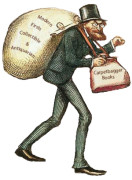Our Bright Young Librarians series continues today with Amelia Hugill-Fontanel of the Rochester Institute of Technology:
What is your role at your institution?
Associate Curator at RIT Cary Graphic Arts Collection. We have a lean staff at the Cary, so we each wear many hats. I curate online and on-site exhibitions, devise programming, and do a lot of special collection library instruction. I write grants and do collection development regarding 19th to 21st century graphic design and printing technology. I oversee several student employees and manage our photographic reproductions for online cataloguing.
How did you get started in special collections?
As an art history undergraduate student, I interned at the George Eastman Museum in Rochester, New York. They hired me after graduation as a curatorial assistant in their photography collection. I have sought special collections positions since then.
Favorite rare book / ephemera that you've handled?
We hold a plaster cast of the right hand of American type designer, Frederic W. Goudy, (1865-1947.) While Goudy was a fine draftsman, his hand was quite large, so the cast is affectionately called “The Paw.” Many years ago, an RIT professor started a legend that whomever touched the Paw would have bad luck for an indeterminate amount of time. That has not happened to me yet, as I have handled it! I would like to think that I’m immune to the curse as I often teach about Goudy in a positive light because of his great accomplishments in design. (Picture of the Paw here: https://www.instagram.com/p/Ba4OL-TD3Bc/)
What do you personally collect?
I collect rocks from my travels. They are small enough to carry in my pocket and best of all, they are free! If the rock has naturally-occurring stripes, that’s a bonus. I love the serendipity of finding a keeper.
What do you like to do outside of work?
I have a personal printmaking practice that overlaps with work. I am a letterpress printer, who uses vintage relief type and printing presses to create fine-press prints. So even though I also get to do this activity in my daily work, whenever I travel, I seek out printshops or technology-history museums. My kids roll their eyes at how many side-trips we’ve taken on a family vacation to see printing presses! (Picture of a poster I designed and printed https://www.behance.net/gallery/99768411/The-Girl-with-the-Cooper-Black-Hair)
What excites you about special collections librarianship?
There is a lot of reward in facilitating research for our patrons in special collections. I have seen it so many times: when a graduate student has an “a-ha!” moment because you brought her the box with items that support her thesis question, or when an artist visually responds and appropriates a piece you showed in a tour. It’s an affirmation that the products of past human endeavors that are held in our collections, have so much to inform the future in scholarship and practice.
Thoughts on the future of special collections librarianship?
Let’s think about the incunabula period in printing history: from 1455 to 1501. This was the first 50 years of printing with moveable type when widespread technology changes in communication informed the next several centuries of publication traditions. We are living right now through the “digital incunabula” period: 1985 to 2035. The digital impact of on-screen reading, graphic reproduction, global access, and applied computer technologies with regard to special collections is palpable but still unquantifiable. So much experimentation is going on to digitally deliver and analyze special collections materials. It’s exciting to be a part of a movement that might have such enduring impact. I think the future of special collections librarianship is right at the intersection of preserving collections while aiding innovative digital research about them.
Any unusual or interesting collection at your library you'd like to draw our attention to?
Cary holds a wide collection of 45,000 books and hundreds of primary source archives on printing, graphic design, and the book arts. In addition to these paper-based collections, we maintain a unique working Technology Collection of 30 printing presses, and thousands of fonts of metal and wood type. My belief is that these industrial realia are preserved through use. I lead printing demonstrations, hold workshops, and produce our own Cary limited-edition prints on this equipment. We are also in the midst of cataloguing our type collections using ArchivesSpace, as there is quite a network around the world of typophiles and printmakers who would appreciate this resource.
Any upcoming exhibitions at your library?
For fall, we are mounting a pop-up exhibition of a portfolio of prints by Amos Paul Kennedy, Jr. Quotes by Rosa Parks are a central theme of this body of work. We wanted to display something inspirational that addresses the current BIPOC movement. We are also working on digital exhibitions, so check our site soon. Or curate your own exhibit from our Digital Collections site!



